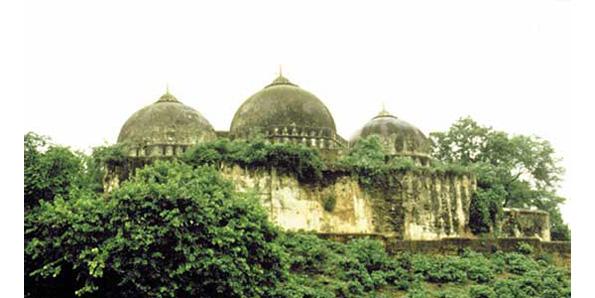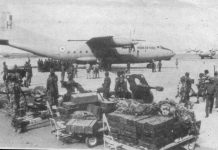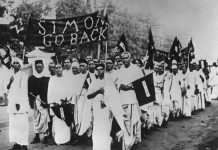India has a rich and interesting history. There are many interesting events from Indian history that every Indian should know. Here are Top 10 Recent Important Events from Indian History.
Robert Clive’s Failed Suicide Attempt
Robert Clive arrived in India in 1744 at Madras. There he worked as an accountant for East India Company at Fort St. George. As the exotic nature of the city started to wear off, he went into depression and tried to commit suicide, but the pistol failed to go off. He survived. From a small time clerk, he went on to become the main strategist for the British rule in India starting from the battle against Siraj-ud-Daula. It is believed that India might not have been conquered by the British if not for this man and his luck pistol.
Emergency of 1975
Indira Gandhi justified the emergency of 1975 on the ground that she was trying to protect the state. The real reasons behind the emergency was that Allahabad High Court in 1975 declaredIndira Gandhi’s election to the Lok Sabha in 1971 from the constituency of Rae Bareli as being void on the grounds of electoral malpractice. Mrs. Gandhi approached the Supreme Court of India to obtain a stay order (suspension) as regards the judgment of the Allahabad High Court. The Supreme Court ruled in her favour and granted the stay of the judgment. It stated that Mrs. Gandhi would continue to remain a member of Parliament, however, she will not be allowed to participate in parliamentary proceedings or vote on matters. The court separately stated that this would not affect Mrs. Gandhi’s position as Prime Minister, allowing her toparticipate in the proceedings of the Parliament in her capacity as Prime Minister (without a right to vote) and perform other functions as Prime Minister. The emergency was declaredsoon after.
There was a lot of outrage among the politically aware about the suspension of rights and the imprisonment of opposition politicians. The BBC World service radio was the de facto source of reliable news in the presence of censorship. There was immense IMF pressure on India to achieve some numbers in population control program. That’s why forced sterilizations/vasectomies were carried out. Men were captured from their fields and streets and taken to hospitals where vasectomies were carried out. Sanjay Gandhi was the most hated for his excesses and for his extra constitutional control over all aspects of government. It was an age of uncertainty where peopled could be sacked, arrested and even disappear somewhere, if they had the audacity to speak out their mind.
The sudden withdrawal of the emergency was unexpected, but was greeted with relief in 1977.
Launch of First Indian Satellite
ISRO’s first satellite, Aryabhata, was launched on 19 April 1975 from Kapustin Yar using a Kosmos-3M launch vehicle by Russia. Developed countries around the world argued that India should first take care of its poverty and take space endeavors seriously later. It was actually a satellite that was built for the purpose of gaining experience in building and operating a satellite in space. It was built to conduct experiments in x-ray astronomy, aeronomics, and solar physics. Though it worked only for four days, it set in motion various space projects over the years that took India to moon and set its eyes on mars. Aryabhata reentered the earth’s atmosphere 11 February 1992. The space race in reality facilitated in India’s progress as satellites gave eyes in the sky, which India successfully used for agriculture, telecommunications, educations and planning.
How Gurdaspur got India Kashmir
Sir Cyril Radcliffe was called to India in June of 1947 to draw the lines separating India and Pakistan. He was called on because he had never been to India before and was therefore unbiased on the lines separating the countries. He started his line from the south of Kashmir with an intention of terminating it in Rajasthan. The line arrived at a little district in Punjab called Gurdaspur. Now, Gurdaspur according to the statistics in his hands had a population of Muslim majority. Radcliffe was with strict orders that Muslim dominated areas were to be given to Pakistan and the Hindu dominated ones to India. Gurdaspur was given to India on the sole fact that giving Gurdaspur to Pakistan would create an awkward bulge into India and would not look good on maps aesthetically.
Punjab & Bengal were partitioned, being the states with almost equivalent Hindu-Muslim majority, while majority of the princely states either acceded to India or Pakistan with the exceptions of Kashmir, Junagarh, Hyderabad. Kashmir decided to be a free state expecting no intervention from Pakistan or India. It was Muslim majority state, ruled by a Hindu ruler, Hari Singh. Jinnah saw him as an eyesore between himself and a bigger country. Jinnah sent his army general to capture Kashmir. Hari Singh’s smaller forces were wrung by Pakistani troops. Hari Singh turned to India for help and Nehru offered to help on a condition to cede Kashmir to India.
Now comes the interesting part. India’s sole contact with Kashmir was Srinagar Airport. Indian Airforce’s capacity to haul in troops into Kashmir was severely limited due to inadequate infrastructure and incapability of flying in tanks. India urgently needed a road capable of handling heavy troops and machinery. The only highway road linking to Kashmir passed through Gurdaspur. Because Gurdaspur was now in Indian territory, National Highway 1 A was used by Indian Army to roll in troops, tanks and howitzers into Kashmir. Seeing the Indian troops with heavy machinery and tanks, Pakistanis quickly retreated into Pakistan and India had a decisive victory. Parts of Kashmir that Pakistan successfully occupied became the Pakistan occupied Kashmir and the other whole of J&K became a part of India. All this was possible all thank to Radcliffe’s decision, who did not give away Gurdaspur because it did notaesthetically please him.
6. Shift from Silver Standard to Gold Standard
Many historians state that India lost its glory and richness due to invasions, foreign culture diluting the traditions, British rule, territorial disputes among the princely states, etc. While all these were ingredients for Indian’s decline, the catalyst for India’s poverty and was the shift from Silver standard to Gold standard. In India, the currency was Rupee. Silver coins were noted to be used in different forms since Magadha kingdom and it was formalized during Sher Shah Suri’s regime of Economic development throughout India. Rupee was official currency of whole of south and south-east Asia and was also adopted in Middle East (Duabi and Qatar till 1959). When it was said that India had glorious past and was a rich country, it didn’t mean just rich kings or rulers, India as a whole was rich. Pre-1868-1898 (1898 being the date when India adopted Gold standard), silver and gold were of equal value, i.e., one silver coin you can get the same amount of gold. But this ratio sharply declined starting from 1872 till 1898, nearly loosing 1/3rd of its value, i.e., 1 rupee was now 30 paise along with this gold value increased tremendously. Another factor was India doesn’t have gold mines to generate their gold and push its value.
In early 19th century, the valuation system updates were not that fast as in today’s internet era, where people could have dumped silver much faster to reduce the loses. The strategy of devaluation of silver and making Gold as standard was devised by Issac Newton. The British had awareness of what impact this change in currency standard will have on Indian economy, but they still did it to gain control over India. Oscar Wilde in his play “The Importance of being Earnest” has a dialogue by Miss Prism to Cecily, “Cecily, you will read your Political Economy in my absence. The chapter on the Fall of the Rupee you may omit. It is somewhat toosensational. Even these metallic problems have their melodramatic side.”
In the paper by Prof.Matthias Morys, University of York and Paper on gold standard and Ottoman Empire by Dr. Cosun Tuncer , it is evidently pointed out that the “Core and Peripheral” system in the Classic gold standard era (1870-1914), where the Core (consisting of British, France, Germany and few other European countries) exploited the exchange rates, interest rates, discount rates, cover ratio and access to foreign reserves for their advantage against Peripheral countries (that included India). For example; England, Germany, France and Netherlands are the only countries whose exchange rate never deprecated more than 1% (i.e. they got more gold for same amount of money every time).
Nomination of Sardar Vallabhai Patel for Prime Minister
It has been said by historians that Sardar Patel was the original choice of the selection committee as the First PM of India. The selection committee contained representatives of Congress Party from 16 states. In the 1946 election for the Congress presidency, Patel stepped down in favour of Nehru at the request of Gandhi. The election’s importance stemmed from the fact that the elected President would lead free India’s first Government. Gandhi asked all 16 states representatives and Congress to elect the right person and Sardar Patel’s name was proposed by 13 states representatives out of 16, but Patel respected Gandhi’s request to not be the first prime minister. There are many unverifiable reasons given for Patel’s change of stance. One among them is that Nehru threatened to break the Congress Party if Patel did not step down and Gandhi saw this as a threat for Indian Independence. Another version of the events dictates that Gandhi regarded Patel as a capitalist and imperialistic leader and Gandhi envisioned India as a socialist nation and thus regarding Nehru to be a better leader than Patel.
Rediscovery of River Saraswati
The last three Vedas (Yajur, Sama & Atharva) gave much importance to Ganga; however, the oldest Veda (Rigveda) revered Indus and Saraswati as the holiest of Indian rivers. In 1995, scientists of the Bhabha Atomic Research Centre (BARC) found that water was available in the Rajasthan desert at depths of merely 50 to 60 meters. The Central Arid Zone Research Institute (CAZRI), Jodhpur, mapped the defunct course of a river through satellite and aerial photographs and field studies. In fact, satellite imagery has given the river scientific teeth. It seems to have originated in Kailash Mansarovar and emerged on the plains from the Siwalik Hills at the foothills of the Himalayas in Himachal Pradesh, flowed through the Ghaggar valley in Haryana and the Rajasthan’s Thar desert, on to Hakra in the Cholistan desert (Sindh, Pakistan), before reaching the Rann of Kutch through the Nara Valley and falling off into the Arabian Sea. Evidences prove that Saraswati dried up or was at least drying up around 3000BC round about the same time the civilization in cities like Mahendragarh, Kalibangan, Dholavira collapsed. The Vedas mention Saraswati in its glorious and wildly magnificent form flowing down from the mountains and enriching the plains. This means the river must have flowed in all its ancient greatness as glorified by the hymns of the Rig Vedic poets at least around 5000BC. As per the latest available research done through Radio Metric Dating, the Indus Saraswati Civilization is now thought to be from 7380 BC. This is on the basis of preliminary findings, released on the 5th November 2012.
Liberalization of 1991
Liberalization of 1991 was one of the important events in Indian history. Right from 1985 Indian economy was in crisis. In 1991, government was close to default, RBI had refused any new credit, and government had only 1 billion US dollars in foreign exchange (only enough to sustain three weeks’ worth of import). India had to pledge 20 tons of gold from reserves to Union Bank of Switzerland. Further 47 tons were transferred to Bank of England as collateral for IMF bailout. Indian currency was devalued and economic reforms were forced upon India. This was all attributed to the Nehru’s practise of heavy industrialization in a socialist economy, introducing license raj for the purpose of ‘infant industry protection’. Before 1991, Indian businesses were micromanaged as the state would determine how much to produce, what was the price, investment, etc. India’s economy was growing only at 3% annually then. In that time of crisis and under the bold leadership of PV Narasimha Rao, Manmohan Singh was chosen as finance minister who brought forth economic liberalization policies by opening up the Indian economy, abolition of license raj system, privatization and deregulation. This brought forth international trade and investment, privatization and tax reforms. India’s growth rates have been impressive since the reforms.
Addition of Sikkim, Goa, Hyderabad and Lakshadweep to India
With the option of acceding to India, Pakistan or total freedom in 1947, a couple of princely states and foreign colonies within India decided to accede to neither of them. The Nizam of Hyderabad (who was among the richest people in the world) declared his intention to remain independent. But Sardar Patel had different thoughts and decided to annex the state of Hyderabad in 1948. About 35000 Indian soldiers fought 22,000 soldiers of the Hyderabad Nizam and 200,000 irregulars. The war ended in just 5 days with 32 casualties on the Indian side and 3500 on the enemy side (with 4000 prisoners). Although the numbers were equally matched, the causalities for India vs the loss for Hyderabad was 1:100.
In case of Goa, the Portuguese ruled Goa for 461 years until 1961. They refused to hand over Goa to India even after the Indian independence. The locals were resisting the Portuguese, but even after many diplomatic efforts, Portugal did not alter their stand. In 1961, India with a massive force outmatched the Portuguese force 10:1 and annexed Goa in just 36 hours.
Sikkim continued to be outside India till 1975 as a suzerainty, as its external affairs were administered by India while internal by themselves. Due to political instability, PM of Sikkim pleaded for statehood. Therefore in April of 1975, Indian Army took over the city of Gangtok and disarmed the monarch’s palace guards and thus it later became the 22nd state of Indian Union.
Lakshadweep belonged to Madras Presidency and therefore belonged to India in accordance with Indian Independence Act 1947. But because the islands had a Muslim majority, it seemed possible that Pakistan might lay claim on the islands. Under the directives of Home Minister, Vallabhbhai Patel, a ship of the Royal Indian Navy reached Lakshadweep and hoisted Indian flag. Hours after the arrival of Indian Navy ship, a few ships of Pakistan Navy were observed on the coastal waters of Lakshadweep, but sensing the Indian presence, they retreated back to Karachi.
Indian States Reorganization
While British left India after partition in 1947, British dissolved their treaty relations with more than 500 princely states. They were encouraged to accede to either India or Pakistan, while under no compulsion to do so. Most of these princely states acceded to India, a few of them acceded to Pakistan and Bhutan and Hyderabad (that India later conquered with military intervention) opted for independence. Most of these states were merged into existing provinces while others were organized into new provinces. Bombay presidency split eventually into Maharashtra, Gujarat in 1960, Punjab split into Haryana into 1966.
Tensions were witnessed in the case of Madras state with the demand of separate Andhra state. Andhra was indeed carved out and enlarged with the inclusion of Telangana part of Hyderabad, which disintegrated into states of Mysore (which later became Karnataka) & Bombay under States Reorganisation Act of 1956. States such as Kerala also came into existence by this act. Madras state was later renamed to Tamil Nadu. Following partition of Punjab, in the quest of a new capital (Lahore was the capital before) Nehru undertook the construction of a new planned city, which was named Chandigarh. Telangana later protested against its merger into Andhra in 1967 unsuccessfully
Assam would be further disintegrated. After an uprising by Naga tribes consisting of civil disobedience and violence, Nagaland was formed in 1962 while Meghalya ceded peacefully in 1972, Arunachal in 1975. Mizo uprising began in 1966 thwarting, which remains the only instance when Government of India used airstrikes on its own civilians. Mizo National Front kept pushing for statehood and achieved Mizoram via diplomatic negotiations in 1987. Manipur & Tripura were Union Territories in 1956, but given state status in 1972. Chhattisgarh, Jharkhand, Uttaranchal ertr the final states to be created that were carved out of Madhya Pradesh, Bihar and Uttar Pradesh respectively in 2000.










































